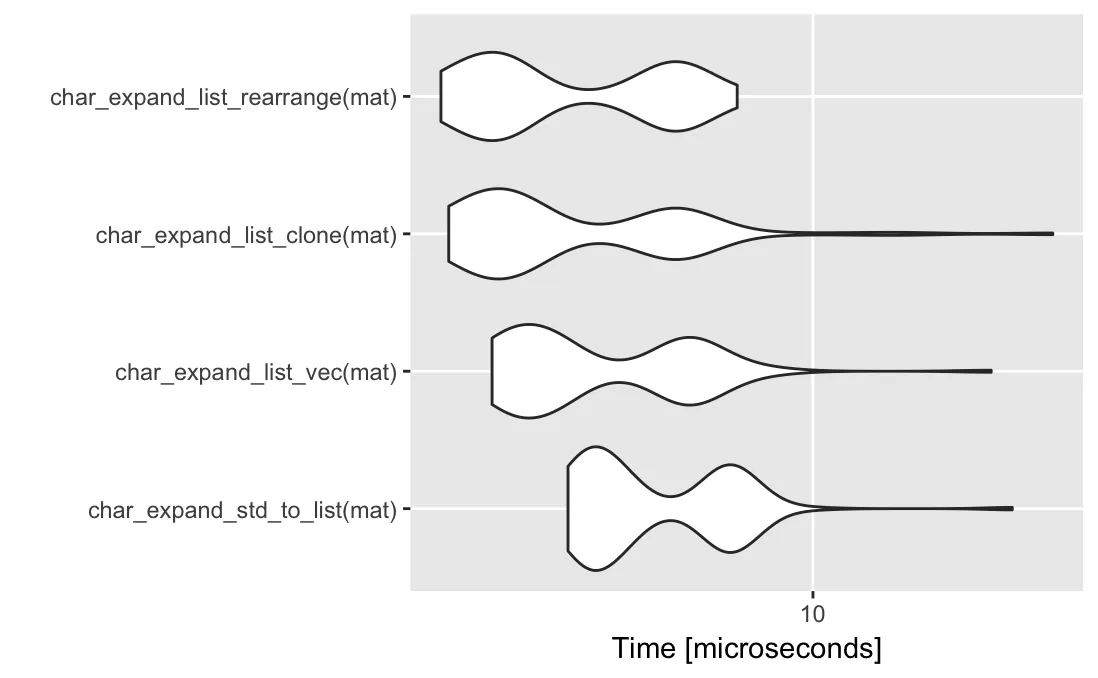这里发生的情况主要是由于 Rcpp 对象的工作方式所致,特别是 CharacterVector 行为像一个指向内存位置的指针。通过在 for 循环外定义该内存位置,结果是一个“全局”指针。也就是说,当循环中更新 B 时,这会随后更新所有方便存储在 Rcpp::List 中的 B 变体。因此,在列表中重复出现的 "c" 行。
使用 .push_back() 在任何 Rcpp 数据类型上都是非常非常不好的想法,因为你最终会不断地复制不断扩大的对象。由于 Rcpp 数据类型隐藏了控制 R 对象的底层 SEXP,必须重新创建,因此将发生复制。因此,您应尝试以下一种方法:
- 将 Rcpp::CharacterVector 的创建重排到第一个 for 循环内部,并预先分配 Rcpp::List 空间。
- 切换到仅使用 C++ 标准库对象,并在结束时转换为适当的类型。
- std::list 与 T 类型为 std::vector (例如 std::string)
- Rcpp::wrap(x) 返回正确的对象或修改函数返回类型从 Rcpp::List 到 std::list>。
- 预分配 Rcpp::List 空间并使用 std::vector 类型 T(例如 std::string)。
- 预分配 Rcpp::List 空间,并在存储在列表中之前对 Rcpp 对象进行 clone()。
在选项1中,我们通过将对B的声明移动到第一个循环中,预分配列表空间并正常访问输出列表来重新排列函数。
#include <Rcpp.h>
using namespace Rcpp;
Rcpp::List char_expand_list_rearrange(Rcpp::CharacterMatrix A) {
Rcpp::List output(A.nrow());
for(int i = 0; i < A.nrow(); i++) {
Rcpp::CharacterVector B(A.ncol());
for(int j = 0; j < A.ncol(); j++) {
B[j] = A(i, j);
}
output[i] = B;
}
return output;
}
选项2
这里我们使用std::vector<std::string>替换了Rcpp::CharacterVector,并将std::list<std::vector<std::string>>代替了Rcpp::List。最后,我们通过Rcpp::wrap()将标准对象转换为Rcpp::List。
#include <Rcpp.h>
using namespace Rcpp;
Rcpp::List char_expand_std_to_list(Rcpp::CharacterMatrix A) {
std::vector<std::string> B(A.ncol());
std::list<std::vector<std::string> > o;
for(int i = 0 ;i < A.nrow(); i++) {
for(int j = 0; j < A.ncol(); j++) {
B[j] = A(i, j);
}
o.push_back(B);
}
return Rcpp::wrap(o);
}
提供:
mat = structure(c("a", "b", "c", "a", "b", "c", "a", "b", "c"), .Dim = c(3L, 3L))
char_expand_std_to_list(mat)
选项 3
或者,您可以保留 Rcpp::List,但提前声明其期望的大小,并仍然使用 std::vector<T> 元素。
#include <Rcpp.h>
using namespace Rcpp;
Rcpp::List char_expand_list_vec(Rcpp::CharacterMatrix A) {
std::vector<std::string> B(A.ncol());
Rcpp::List o(A.nrow());
for(int i = 0; i < A.nrow(); i++) {
for(int j = 0; j < A.ncol(); j++) {
B[j] = A(i, j);
}
o[i] = B;
}
return o;
}
选项4
最后,在为列表预定义空间的情况下,每次迭代都会显式克隆数据。
#include <Rcpp.h>
using namespace Rcpp;
Rcpp::List char_expand_list_clone(Rcpp::CharacterMatrix A) {
Rcpp::CharacterVector B(A.ncol());
Rcpp::List output(A.nrow());
for(int i = 0; i < A.nrow(); i++) {
for(int j = 0; j < A.ncol(); j++) {
B[j] = A(i, j);
}
output[i] = clone(B);
}
return output;
}
基准测试
基准测试结果表明,通过重新排列和预分配空间的选项1表现最佳。其次是Rcpp::List中每个向量保存前进行克隆的选项4。
library("microbenchmark")
library("ggplot2")
mat = structure(c("a", "b", "c", "a", "b", "c", "a", "b", "c"), .Dim = c(3L, 3L))
micro_mat_to_list =
microbenchmark(char_expand_list_rearrange(mat),
char_expand_std_to_list(mat),
char_expand_list_vec(mat),
char_expand_list_clone(mat))
micro_mat_to_list

